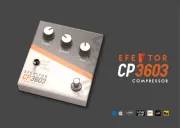SONORIS Meter VST 2.0 Handleiding
SONORIS
Audiosoftware
Meter VST 2.0
Bekijk gratis de handleiding van SONORIS Meter VST 2.0 (11 pagina’s), behorend tot de categorie Audiosoftware. Deze gids werd als nuttig beoordeeld door 53 mensen en kreeg gemiddeld 3.6 sterren uit 27 reviews. Heb je een vraag over SONORIS Meter VST 2.0 of wil je andere gebruikers van dit product iets vragen? Stel een vraag
Pagina 1/11

Sonoris Meter VST 2.0
User Manual
Introduction
© 2008 Pieter Stenekes
info@sonoris.nl
Copyright © Sonoris Audio Engineering 2008 – www.sonoris.nl 1/11

Thank you for choosing Sonoris Meter!
What is it?
With this plugin, you can accurately measure peak and loudness levels of audio signals, at one scale.
Besides a regular meter scale the Sonoris Meter supports the K-System, from Bob Katz, mastering engineer
and founder of Digido mastering studio. During the development period of this plugin Bob Katz was very
helpful in providing information. The end product closely follows the K-system specifications, including
Leq(A) loudness metering and bandlimited pink noise monitor calibration.
The Sonoris Meter features an oversampling mode. In this mode the meter catches intersample peaks that
can cause ear fatiguing sound when audio is played on consumer CD players. Many CD players have
inferior D/A converters with little headroom that will distort with samples above the clip level. These peaks
occur when the audio is clipped (read squashed / limited) or otherwise digitally manipulated (eg. VSTi's). In
oversampling mode the Sonoris Meter models the D/A conversion process and allows for maximizing the
level but avoiding this distortion.
At the bottom of the interface a correlation meter can be found. This meter enables the user to monitor the
phase relationship between the left and right channels.
About the plugin
All calculations are performed with 64 bit integer math except for the filters.
Basic Operation
Click on a button to active or deactivate the corresponding function. Controls can be changed with the mouse
by dragging up or down or by clicking on the small arrows. An added feature is the possibility to adjust the
controls with the mousewheel.
Clicking on the meter values above the meter bars resets them. If a clipping incident occurred, the clipping
indicator can be reset by clicking on it.
About this helpfile
This helpfile explains all settings and options, as well as basic K-System theory. For more in-depth
information please visit www.digido.com.
Have fun!
Copyright © Sonoris Audio Engineering 2008 – www.sonoris.nl 2/11
Product specificaties
| Merk: | SONORIS |
| Categorie: | Audiosoftware |
| Model: | Meter VST 2.0 |
Heb je hulp nodig?
Als je hulp nodig hebt met SONORIS Meter VST 2.0 stel dan hieronder een vraag en andere gebruikers zullen je antwoorden
Handleiding Audiosoftware SONORIS

4 Maart 2024

4 Maart 2024

4 Maart 2024

4 Maart 2024

4 Maart 2024

4 Maart 2024

4 Maart 2024
Handleiding Audiosoftware
- Atomix
- Ujam
- Kuassa
- IK Multimedia
- CEDAR
- D16 Group
- Magix
- Corel
- Steinberg
- Chocolate Audio
- Overloud
- Blue Cat Audio
- TAL Software
- Slate Digital
- Applied Acoustics Systems
Nieuwste handleidingen voor Audiosoftware

3 September 2025

2 September 2025

2 September 2025

1 September 2025

1 September 2025

1 September 2025

1 September 2025

1 September 2025

1 September 2025

1 September 2025